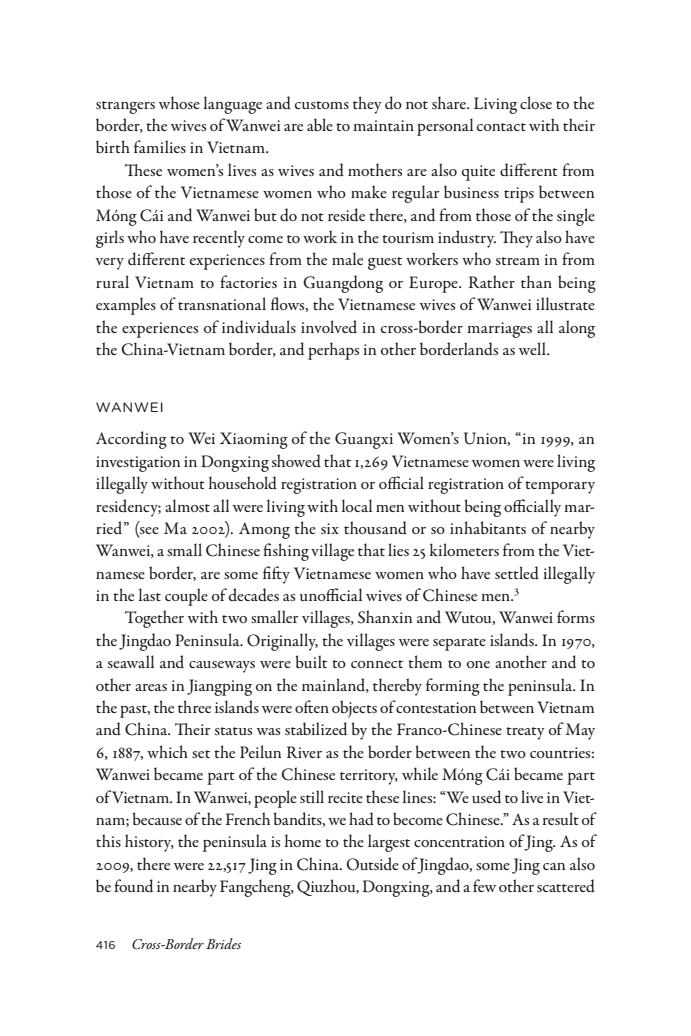正在加载图片...

strangers whose language and customs they do not share.Living close to the border,the wives of Wanwei are able to maintain personal contact with their birth families in Vietnam. These women's lives as wives and mothers are also quite different from those of the Vietnamese women who make regular business trips between Mong Cai and Wanwei but do not reside there,and from those of the single girls who have recently come to work in the tourism industry.They also have very different experiences from the male guest workers who stream in from rural Vietnam to factories in Guangdong or Europe.Rather than being examples of transnational flows,the Vietnamese wives of Wanwei illustrate the experiences of individuals involved in cross-border marriages all along the China-Vietnam border,and perhaps in other borderlands as well. WANWEI According to Wei Xiaoming of the Guangxi Women's Union,"in 1999,an investigation in Dongxing showed that 1,269 Vietnamese women were living illegally without household registration or official registration of temporary residency;almost all were living with local men without being officially mar- ried"(see Ma 2oo2).Among the six thousand or so inhabitants of nearby Wanwei,a small Chinese fishing village that lies 25 kilometers from the Viet- namese border,are some fifty Vietnamese women who have settled illegally in the last couple of decades as unofficial wives of Chinese men. Together with two smaller villages,Shanxin and Wutou,Wanwei forms the Jingdao Peninsula.Originally,the villages were separate islands.In 1970, a seawall and causeways were built to connect them to one another and to other areas in Jiangping on the mainland,thereby forming the peninsula.In the past,the three islands were often objects of contestation between Vietnam and China.Their status was stabilized by the Franco-Chinese treaty of May 6,1887,which set the Peilun River as the border between the two countries: Wanwei became part of the Chinese territory,while Mong Cai became part of Vietnam.In Wanwei,people still recite these lines:"We used to live in Viet- nam;because of the French bandits,we had to become Chinese."As a result of this history,the peninsula is home to the largest concentration of Jing.As of 2009,there were 22,517 Jing in China.Outside of Jingdao,some Jing can also be found in nearby Fangcheng,Qiuzhou,Dongxing,and a few other scattered 416 Cross-Border Bridesùõû Cross-Border Brides strangers whose language and customs they do not share. Living close to the border, the wives of Wanwei are able to maintain personal contact with their birth families in Vietnam. These women’s lives as wives and mothers are also quite different from those of the Vietnamese women who make regular business trips between Móng Cái and Wanwei but do not reside there, and from those of the single girls who have recently come to work in the tourism industry. They also have very different experiences from the male guest workers who stream in from rural Vietnam to factories in Guangdong or Europe. Rather than being examples of transnational flows, the Vietnamese wives of Wanwei illustrate the experiences of individuals involved in cross-border marriages all along the China-Vietnam border, and perhaps in other borderlands as well. WANWEI According to Wei Xiaoming of the Guangxi Women’s Union, “in 1999, an investigation in Dongxing showed that 1,269 Vietnamese women were living illegally without household registration or official registration of temporary residency; almost all were living with local men without being officially married” (see Ma 2002). Among the six thousand or so inhabitants of nearby Wanwei, a small Chinese fishing village that lies 25 kilometers from the Vietnamese border, are some fifty Vietnamese women who have settled illegally in the last couple of decades as unofficial wives of Chinese men.3 Together with two smaller villages, Shanxin and Wutou, Wanwei forms the Jingdao Peninsula. Originally, the villages were separate islands. In 1970, a seawall and causeways were built to connect them to one another and to other areas in Jiangping on the mainland, thereby forming the peninsula. In the past, the three islands were often objects of contestation between Vietnam and China. Their status was stabilized by the Franco-Chinese treaty of May 6, 1887, which set the Peilun River as the border between the two countries: Wanwei became part of the Chinese territory, while Móng Cái became part of Vietnam. In Wanwei, people still recite these lines: “We used to live in Vietnam; because of the French bandits, we had to become Chinese.” As a result of this history, the peninsula is home to the largest concentration of Jing. As of 2009, there were 22,517 Jing in China. Outside of Jingdao, some Jing can also be found in nearby Fangcheng, Qiuzhou, Dongxing, and a few other scattered